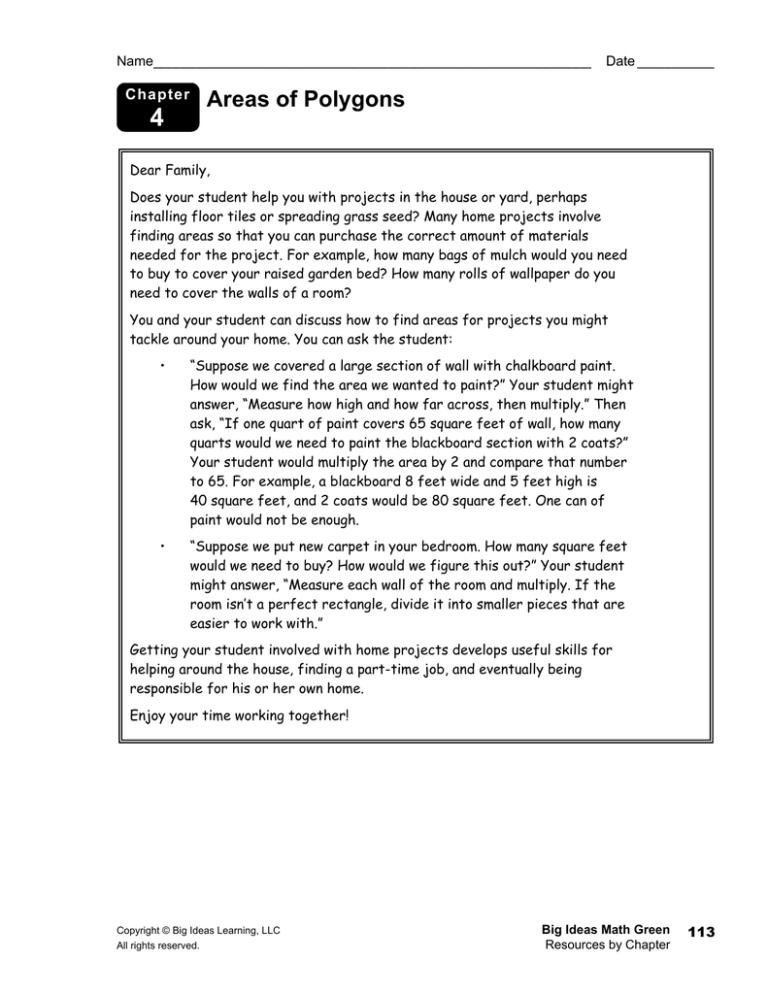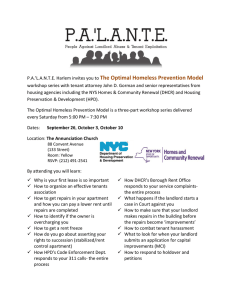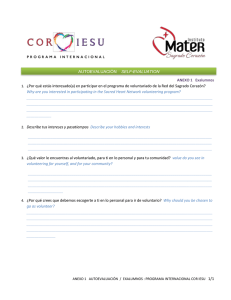Areas of Polygons
Anuncio

Name_________________________________________________________ Chapter 4 Date __________ Areas of Polygons Dear Family, Does your student help you with projects in the house or yard, perhaps installing floor tiles or spreading grass seed? Many home projects involve finding areas so that you can purchase the correct amount of materials needed for the project. For example, how many bags of mulch would you need to buy to cover your raised garden bed? How many rolls of wallpaper do you need to cover the walls of a room? You and your student can discuss how to find areas for projects you might tackle around your home. You can ask the student: • “Suppose we covered a large section of wall with chalkboard paint. How would we find the area we wanted to paint?” Your student might answer, “Measure how high and how far across, then multiply.” Then ask, “If one quart of paint covers 65 square feet of wall, how many quarts would we need to paint the blackboard section with 2 coats?” Your student would multiply the area by 2 and compare that number to 65. For example, a blackboard 8 feet wide and 5 feet high is 40 square feet, and 2 coats would be 80 square feet. One can of paint would not be enough. • “Suppose we put new carpet in your bedroom. How many square feet would we need to buy? How would we figure this out?” Your student might answer, “Measure each wall of the room and multiply. If the room isn’t a perfect rectangle, divide it into smaller pieces that are easier to work with.” Getting your student involved with home projects develops useful skills for helping around the house, finding a part-time job, and eventually being responsible for his or her own home. Enjoy your time working together! Copyright © Big Ideas Learning, LLC All rights reserved. Big Ideas Math Green Resources by Chapter 113 Nombre _______________________________________________________ Fecha ________ Capítulo 4 Áreas de polígonos Estimada Familia: ¿Su estudiante lo ayuda con proyectos en la casa o el jardín, quizás instalando baldosas o esparciendo semillas de hierba? Muchos proyectos del hogar incluyen hallar los perímetros y áreas para que pueda comprar la cantidad correcta de materiales necesarios para el proyecto. Por ejemplo, ¿cuántas balsas de abono necesitaría comprar para cubrir su jardín elevado? ¿Cuántos rollos de empapelado necesita para cubrir las paredes de una habitación? Usted y su estudiante pueden discutir cómo encontrar áreas para proyectos que podría iniciar en casa. Puede preguntar al estudiante: • “Supongamos que cubrimos una gran sección de pared con pintura de pizarra. ¿Cómo hallaríamos el área que queremos pintar? Su estudiante podría responder: “Medimos la altura y la longitud, luego multiplicamos”. Luego pregunte: “Si un cuarto de pintura cubre 65 pies cuadrados de pared, ¿cuántos cuartos necesitaríamos para pintar la sección de la pizarra con 2 capas?” Su estudiante debería multiplicar el area por 2 y comparar ese número con 65. Por ejemplo, una pizarra que mide 8 pies de ancho y 5 pies de alto tiene 40 pies cuadrados, y 2 capas serían para 80 pies cuadrados. Una lata de pintura no sería suficiente. • “Supongamos que colocamos una alfombra nueva en su habitación. ¿Cuántos pies cuadrados tendríamos que comprar? ¿Cómo hallaríamos esto? Su estudiante podría responder: “Mide cada pared de la habitación y multiplica. Si la habitación no es un rectángulo perfecto, divídela en pedazos más pequeños que sean más fáciles de trabajar”. Si logra que su estudiante se involucre en proyectos caseros, éste desarrollará las habilidades útiles para ayudar en casa, encontrando un trabajo a tiempo parcial, y eventualmente siendo responsable de su propio hogar. ¡Disfruten su tiempo trabajando juntos! 114 Big Ideas Math Green Resources by Chapter Copyright © Big Ideas Learning, LLC All rights reserved.


